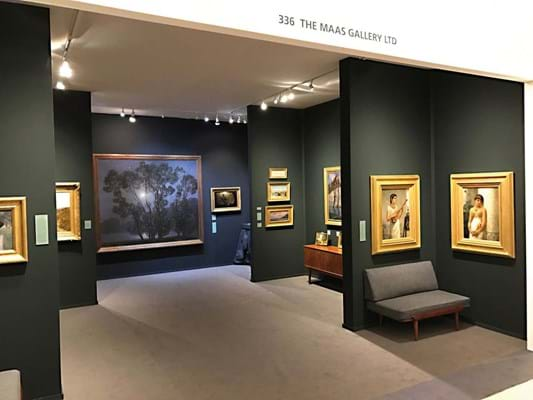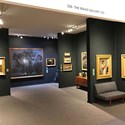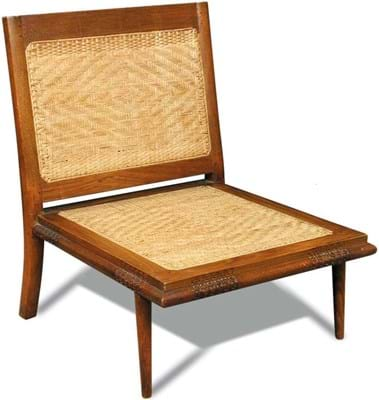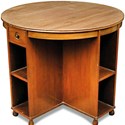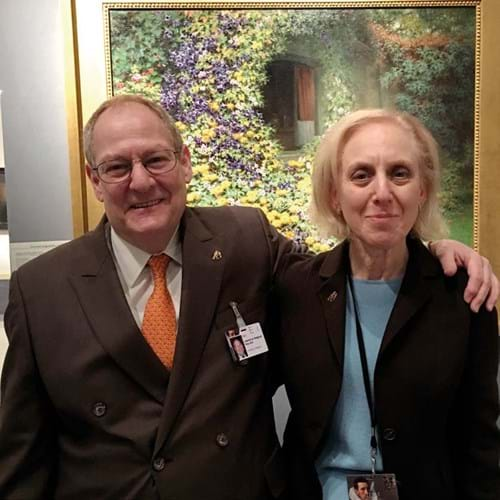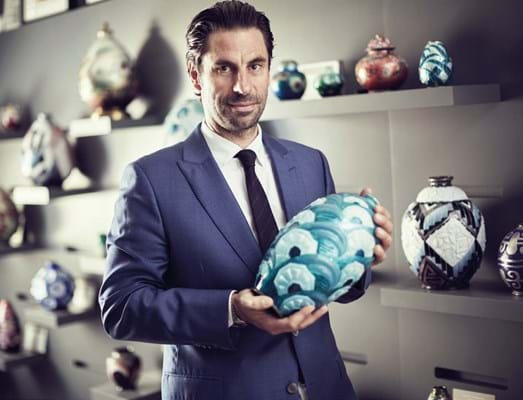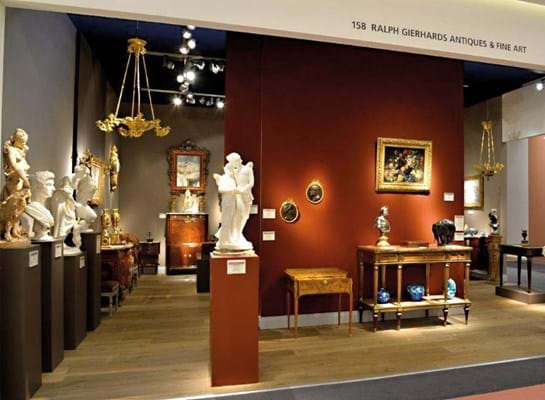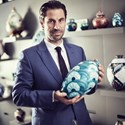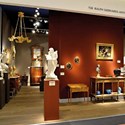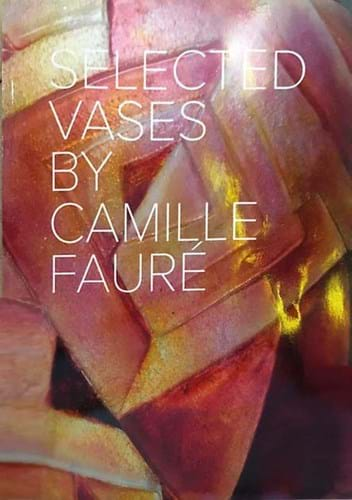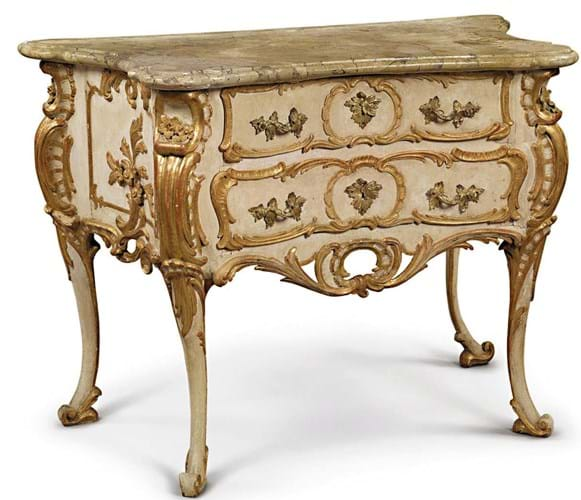RUPERT MAAS: “I’m panicking a bit. I’m going sailing and half of our pictures aren’t back from the restorers”
The Maas Gallery is based in London and deals in Victorian, Pre-Raphaelite, Romantic and Modern British pictures and sculpture. It was founded in 1960 by Jeremy Maas and since 1993 has been run by his son Rupert, a specialist on the BBC’s Antiques Roadshow. The gallery has been showing at TEFAF for seven years.
NOVEMBER 30, 2017:
TEFAF’s stand-building contractors Stabilo were in town and I had an appointment with them at the Cavendish Hotel. It was important to meet them because TEFAF has unilaterally decided to move us, to a corner stand opposite the bar. They do that without consultation, because they “would never get anything done otherwise”.
I’m hoping that will be a good thing, that we’ll see more people, although a corner stand has fewer walls, and you don’t want to hang too many pictures because your stand will look too busy. We learnt that at our first TEFAF.
People go to TEFAF for punchy and important works. We’re taking a double self-portrait by Madeline Green (1884-1947), a British painter in the 1920s and ’30s. She spent much of her life hermetically sealed in Ealing, just doing her own thing, a bit like Stanley Spencer in Cookham.
She’s not widely known in the UK, but she exhibited at the RA and a lot at the Paris Salon, where she was taken seriously. Modern for her time, Green painted herself, twice in some pictures. It’s not the most expensive work, but it is the most arresting. I’ve no idea how it will do.
DECEMBER 21, 2017:
Stabilo has done a fantastic job designing the stand with two discrete, colour-coded areas – blue and green. We might use one of them to make a feature of Pre-Raphaelite works on paper.
We have the best Edward Burne-Jones (1833-98) drawing we’ve ever had, incredibly delicate: it’s up for €250,000. It’s of his lover Maria Zambaco at the height of their affair and is very sensual.
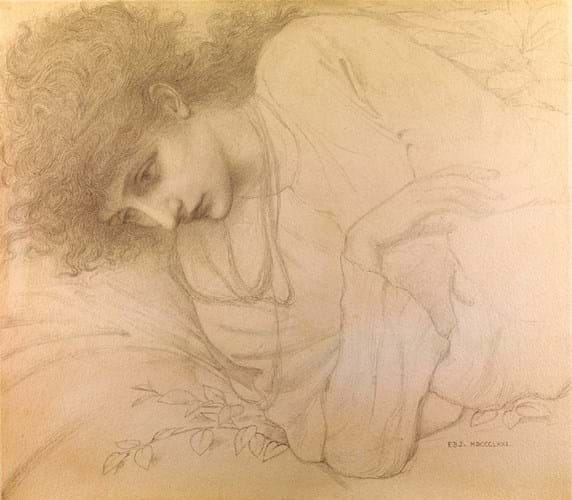
An Edward Burne-Jones drawing of his lover Maria Zambaco priced at €250,000 on the Maas Gallery stand
Stabilo also suggested changing a corner post for a ceiling support, but it would have cost us €1500, so we’re not going to do it. It’s expensive to use Stabilo, but they’re very good and you know they’re going to get it right. We’ve got to rejig our lighting now, which we do ourselves. I’ll lay out the track in the garden before we go; it’s the only safe way.
We’ll leave the labelling until the New Year. Labels should inform, educate and entertain, as Lord Reith would say. I take my cue from John Gere, former keeper at the British Museum: anything you write should be directly relevant to the picture. I must remember to book the van, though. I’m much more DIY than most dealers. I drive our pictures out myself in a Ford Transit.
JANUARY 29, 2018:
I’m panicking a bit. I’m going sailing for 10 days and half of our pictures aren’t back from the restorers. I’ve also been wrangling with my framers – many dealers have an adversarial relationship with their framers, I find. I take a lot of trouble over the framing – if a picture doesn’t sing, it won’t sell.
On the plus side, Lizzy Weintz (our gallery manager) is brilliant at looking after things while I’m away.
I have also booked the van and the Eurotunnel freight train. That’s great fun. You park your van and are taken by taxi to a passenger carriage to share a moment with Eastern European lorry drivers with a questionable taste in jeans.
We still have free movement of goods across Europe – for the moment – but we’ll need a manifest listing the works and their value. The border guards have a gadget that can X-ray the entire van.
And insurance – I have to take an extra person in the van with me because, under the terms of my insurance contract, I am not allowed to leave the works unattended. We’ll take 40-50 pictures and hang about two-thirds of them.
I’ve gone mad and bought some mid-century modern furniture for the stand, so we’ll be taking that out, too. There’s a library table by Ambrose Heal, a 1920s side table by Betty Joel, both in walnut, and a 1950s chair by Indian designer Leela Shiveshwarkar.
FEBRUARY 5, 2018:
I’m off on holiday tomorrow. I’ll be emailing Lizzy from the boat. I’ve just discovered a new light I’m excited about: something called an LED GU10 by Soraa: you put lenses on the front of lamps to change the shape of the beam. Stabilo doesn’t have them, so I need to buy those before I leave.
We’ll be travelling to Maastricht on March 1. I stay with friends: she’s Canadian and the best translator of art reference works from Dutch to English in the world, and he’s Swiss and a retired cellist with the Orchestre de Liège. He also helps me build and man the stand – he speaks seven languages. It’s a great advantage because, although I’m a quarter-Dutch, I only speak a bit of French.
I’ve learnt how to make the best of TEFAF.
I cycle every morning to get some air. And I take my dinghy and sail up and down the River Maas on my day off. I’ve launched the TEFAF sailing club: it has a membership of one.
“I sail up and down the River Maas on my day off. I’ve launched the TEFAF sailing club: it has a membership of one.” Rupert Maas
It’s a good fair – the only one we do. I have an evangelical zeal about showing British pictures in Europe. When we first showed at the New York Armory, a dealer told me ‘selling British pictures in this town is missionary work’. We hardly ever saw American museums there, but they all come to Maastricht, on tour with their docents, trustees and benefactors; it’s fun for them.
Up to 7000 people pass through every day, which is as much as you can hope for during the full duration of other fairs. They really look at the works on show, too, and don’t care how much they cost or where they’re from. They take them on their own merits.
* * * * *
LARRY AND PEGGY STEIGRAD: ‘TEFAF costs us €100,000 before we make a dime, but it's our lifeblood'
Lawrence Steigrad Fine Arts is a New York gallery dealing in Old Master and British paintings, drawings, and sculpture from the 16th to 19th centuries. The gallery, founded in 1989 by husband and wife Lawrence Steigrad and Peggy Stone, has been showing at TEFAF since 2006.
DECEMBER 7, 2017:
Larry writes: We’ve been focusing on our booth this week. TEFAF has changed our stand shape – it used to be square, now it’s horizontal.
We’ve asked Stabilo to make the centrepiece a painting by Adrien Louis Demont (1851-1928) of a hyacinth nursery in Ghent. We showed it at TEFAF five years ago and sold it to an American couple. They had it in a house they don’t spend much time in, though, so they’ve consigned it back to us. We’d like it to go to a European museum where it belongs.

A hyacinth nursery in Ghent by Adrien Louis Demont will be the centrepiece of the Lawrence Steigrad Fine Arts stand
Peggy’s also been working on our new ‘children’s book’. We’ve always done traditional catalogues, but in June we did something different, a children’s book about a Siberian husky called Leyster, that features our sculpture and paintings. A client saw a painting in it by Johannes Leemans (1633-88) – Trompe l’Oeil Still Life with a Bird Cage, Birdcalls, and a Powder-Bag – and bought it.
The new book is specifically for Maastricht. It’s called Leyster goes to Holland and incorporates many of the paintings, drawings and sculpture we’re intending to show there.
DECEMBER 20, 2017:
We thought this week would be dead, but not a bit of it. We’re still working on our booth and have been thinking about our labels and talking to restorers and framers.
We need a new frame for a Jacob Salomonsz. van Ruysdael (1629-81) that was last sold in 1929 in Amsterdam. It went to Czechoslovakia, the Nazis almost got hold of it, but it made its way to California. Peggy’s trying to track down a catalogue entry.
We’ve also started planning our shipments to both the Palm Beach Jewelry, Art & Antique Show and Maastricht.
The shipper came by for a Christmas drink and we’ve had a film crew here doing a piece about New York dealers exhibiting at TEFAF. At this rate, we’ll still be here on Christmas Eve.
JANUARY 9, 2018:
Back to logistics. A truck will pick up about 45 paintings and sculptures on February 8. It will take everything to Florida for Palm Beach, but we’ll hold some things back for TEFAF. The Maastricht shipment will go by freight plane in three to four big crates.
There’s quite a bit of paperwork to do: a list for customs and images and fact sheets for the Art Loss Register. The ALR team pre-vet everything to catch anything that might have been stolen.
TEFAF is a lot of work and it’s not cheap: from New York to back again, it costs us around €100,000 before we make a dime. But it’s the lifeblood of our business.
At last year’s fair we made three museum sales, including a Cornelis Jacobsz Delff (1570-1643) to the Museum Prinsenhof Delft. It had hung in the home of the Burgomaster of Delft until 1653.
JANUARY 30, 2018:
Peggy’s been organising the fact sheets and photos for the booth – some people still want it the old way – and our gallery director Emily has been sorting out QR tags, so art advisers will be able to just take out their iPhones and download the data.
I think we’re on track for TEFAF but it’s a fluid process. One picture has just sold and others have come in: a snow scene from 1858, Loading the Sleigh by Andreas Schelfhout (1787-1870), that’s been in a private collection in Maryland since 1985, and Fleurs de Printemps by Albert-Émile Artigue (1850-1927), a masterpiece by an obscure late 19th century artist. It should look great with the Demont hyacinths.
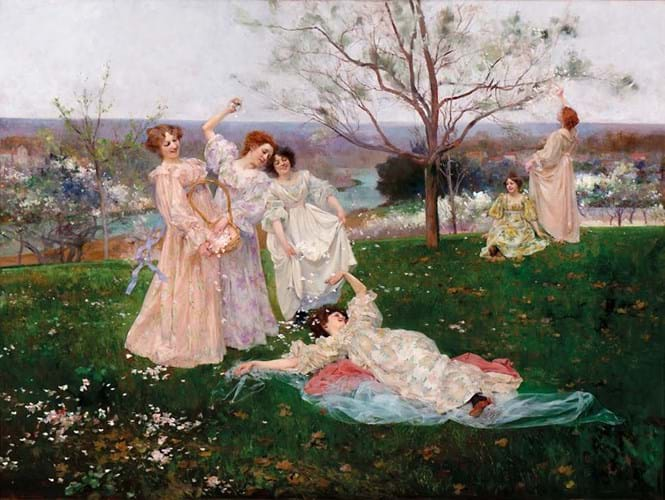
The joys of spring c.1890, Fleurs de Printemps by Albert-Emile Artique from Lawrence Steigrad Fine Arts
Palm Beach is coming up fast. I’m sending out tickets for our VIP event and Peggy has been asked to vet there – and there has also been the Winter Antiques Show at the Armory.
I was asked to stand in at the last minute for the Young Collectors’ Night, and on Sunday we took a group of eight people who were here for the Old Master auctions and our restoration lab in Maine for dinner.
FEBRUARY 9, 2018
Peggy writes: The shipment went today. Everything seems to be under control, except we forgot to pack the printer! We fly to Florida on Monday for 10 days and we go to Maastricht on March 2.
Setting up is full-on and anything can happen. One year we lost a crate with all of our books, documents and tools in it – another gallery had it by mistake. We’ve been invited to a private view of Meeting Barthold Suermondt – A New Taste for the Arts at the Suermondt-Ludwig Museum in Aachen while the vetting committee comes in on the Tuesday. It should be wonderful, but you’re always a bit antsy until you’re back in.
There’s no other fair that gets 75,000 visitors and it helps that Larry speaks Dutch – his mother is from Holland and his dad is from Belgium. The locals like the New York accent. They find it cute.
It’ll be interesting to see how everything goes down.
The Van Ruysdael has been buried in California for years, so is very fresh to the market, and the Artigue is an intriguing picture: it looks like a bunch of women belting each other with petals, but it has such an interesting back-story.
Women suddenly had a lot more freedom in 1890s Paris: they could ride bikes and go off together for the weekend, and their gowns were looser, with less corseting. So the painting is essentially about that – about women feeling free and having a good time.
It’s a picture for these times – but you never really have any idea how things will do. We’re usually wrong!
* * * * *
RALPH GIERHARDS: “Objects come in and you suddenly have to do a lot of research. You have to be like a cook and whip things up quick”
Based in Düsseldorf, Ralph Gierhards deals in antiques and fine art. He took over the gallery from his father, who first showed in Maastricht in 1993.
DECEMBER 4, 2017:
We’ve been looking at our stand this week, and where to put each object on it. I went to the Netherlands for my meeting with Stabilo a month ago, and it’s something I take quite seriously. I try to show antiques in a modern way – I was one of the first dealers to display gilded bronzes on the wall, on floating shelves – and I show Camille Fauré (1872-1944) pieces on mirrored glass, so they are reflected from all angles.
You do have to be flexible, though. You start buying immediately after the previous fair, but things get sold.
This year, I’ll be showing a green-painted rococo fountain that was made in Munich in c.1740 in one corner, some rare gold boxes in a vitrine, a pair of terracotta sanctuary lamps attributed to Baron Henry de Triqueti (1803-74) that may show the arms of the Medici family, and an important parcel-gilt and white-painted Bamberg commode from c.1750 that was formerly at the Met in New York.
DECEMBER 21, 2017:
We’ve been doing our list of objects and prices for the jury and making the labels for each piece. We’ve got about 150 to do in total and some are quite last-minute. It’s not like you know everything you’re taking months in advance.
Things come in from private collections and you suddenly have to do a lot of research while objects can be with restorers in Germany or Paris for a long time and arrive at the gallery quite late in the day – some are even delivered directly to the fair. You have to be like a cook and whip things up quick!
I’ve also been tied up with a catalogue about Camille Fauré’s Limoges vases that’s due here at the beginning of February. I’ve invested a lot of money and time into it.
I love Fauré – the bright, strong colours, the Art Deco detailing, the enamelling. I’ll be taking 35-40 of his pieces to Maastricht. Some came direct from the family in Limoges, one came from Argentina.
JANUARY 29, 2018:
I had a second meeting with Stabilo last week – there was an issue with the design of our booth that we needed to discuss. Anyway, we have now decided not to show the Camille Fauré Art Deco vases on mirrored glass because it’s all too fragile. So, we’re presenting them in a normal glass vitrine with eight shelves.
On a more positive note, 500 copies of our new Fauré catalogue were delivered at the gallery today. I’m delighted with it.
FEBRUARY 8, 2018:
It’s carnival here in Düsseldorf at the moment, so things aren’t as busy as they can be. We’ve been working on a newsletter to send to clients, along with the Fauré catalogues, and I’ve just been to Saarbrücken – a six-hour round trip – to deliver a painting and check on the restoration of the Bamberg commode.
It’s like a baby – you have to keep a constant eye on it. I’m off to Paris this weekend to pick up some pieces for TEFAF from one of our restorers. We tend to use French restorers for our fabrics, gilded bronzes and French furniture, and German restorers for German furniture.
I also sold a big painting, Henri Lebasque’s La Seine à Paris, yesterday, so that was a good day. I was planning to show it at TEFAF, but we’ve got others.
We’re all set to start packing up the smaller items on February 26, two days before our shipper arrives from Cologne with the big boxes. I do worry that things will get damaged, but I’m looking forward to it.
You can’t take TEFAF for granted, you have to make an effort: choose your best pieces, be clear in your descriptions.
But it’s my favourite fair. I grew up there in a way – it’s like going home.


